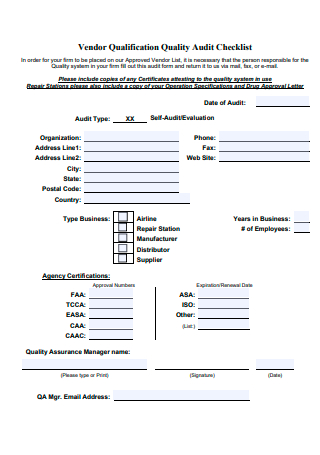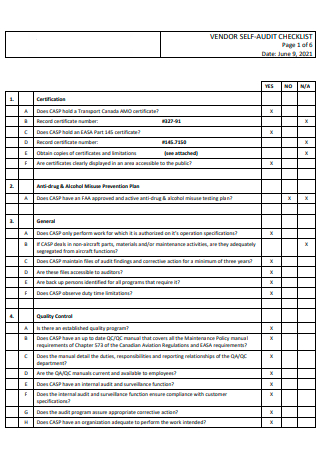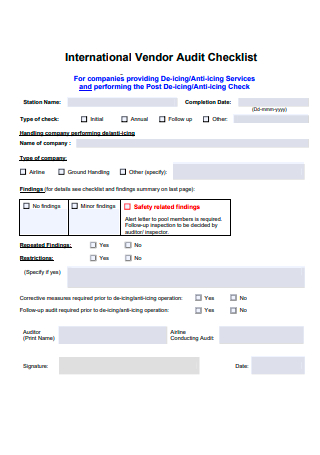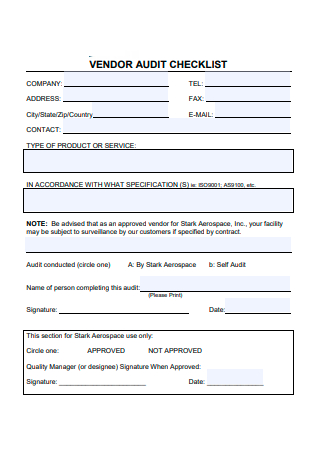3+ Sample Vendor Audit Checklist
FREE Vendor Audit Checklist s to Download
What Is a Vendor Audit Checklist?
A vendor Audit Checklist is used to confirm that the vendor’s quality management system (QMS) satisfies the company’s criteria. Vendors as well as the company to sell the product or service can use this checklist to document and report any noncompliance with quality requirements. Organizations employ a vendor audit to assess a third-party provider they have hired. An audit might examine a variety of topics, including the organization’s quality control, costs and benefits, cybersecurity protection, and other factors. If you are pressed for time, you can use the vendor audit checklist template as a ready-made document available within the article.
Importance of Auditing
The study and verification of a company’s financial records are described by the term audit in accounting. Audits are also performed to ensure that financial statements are presented according to accounting standards. Without adequate controls and standards, auditors can easily fabricate financial information, making the company appear more profitable or successful than it is. Auditing is required to ensure that firms accurately and fairly present their financial situation following accounting standards.
Items to Include in Vendor Audit Checklists
Vendor audits include evaluations of both generic and particular processes, depending on the supplier category. Since the specific questions differ from sector to industry and even between organizations, any system used to perform vendor audits and discuss results must allow you to edit your Supplier Audit Checklist templates. Most supplier audit templates can incorporate the things stated in the vendor audit checklist template to ensure vendors satisfy their quality standards and specifications. Before you jump right into writing the vendor compliance audit checklist, give this curated list a read first to be aware of what to include within the checklist.
Requirements and Design Management: Ensure that the provider can transform the customer’s expectations into a high-quality product at a reasonable price. You must confirm that the supplier’s client satisfaction is assured. The supplier must demonstrate how client requirements are managed and incorporated into product design. Vendors must be able to reach the requirements and necessary design requested by the client or Company.On-Time Delivery Capability: This is provided to ensure timely delivery while also ensuring the quality of the goods delivered. On-time delivery promotes improved customer collaboration, delivery reliability, and, most importantly, customer loyalty. It’s critical to set and meet the correct expectations with your customers. This goes for vendors or suppliers as well, as they are expected to deliver the products or equipment for the service on time so that the customers can utilize it as well. Make sure vendors can commit to being able to deliver on time.Vendor’s Own Supply Chain: A supply chain is the web of people, Organizations, resources, activities, and technology involved in the production and distribution of a product. Everything from the delivery of source materials from the supplier to the producer to the final distribution to the end-user is included in a supply chain. Include goods that provide reliable and cutting-edge supply chain operations, on-time delivery, and proactive demand management. Ascertain that the supplier’s entire supply chain is capable of meeting the needs and is constantly striving to improve.Inspecting Incoming Products: When checking incoming products, the following points should be covered such as the process and technique used to ensure that inspection is done correctly, standardized, and codified. The purpose of entering inspection tools and expertise is to ensure that the tests can be completed appropriately. Despite trusting the vendor and having established a thorough relationship with them, you or your company still need to perform an inspection so that any malfunctions or broken products can be brought to the attention of the vendor before reaching the customer.Environment, Health, and Safety: The precise environment, health, and safety checks may differ, but the provider must have a mechanism in place to prevent accidents and ensure that the crew is well-trained and healthy. There should be a system in place for continuously enhancing safety and eliminating waste. If hazardous items are handled, appropriate handling procedures should be in place. Finally, labor rules particular to each country, as well as international ethical standards, should be scrupulously adhered to.Key Performance Indicators and Quality Audits: A culture of continual improvement should be in place, and it should be reflected in the supplier’s audits. Throughout the value chain, the supplier should have trustworthy data to establish action plans that will increase performance and consequently customer satisfaction. The entire company should be involved. To be able to check the supplier’s standards and procedures, access privileges must be in place. The supplier must possess the necessary quality certifications as well as quality management tools.Risk Management and Test Procedures: Obsolescence, discontinuity, and supplier bankruptcy should all be planned for. To avoid using or counterfeiting parts, procedures should be in place. Risk Management is used in new product development to reduce time to market by removing potential obstacles and barriers early on, making changes easier and more economical, eliminating potential failures, design faults, and defects, and reducing extra effort. Test procedures should be present for any development of a product because you don’t want it to go wrong when a customer uses it.
Types of Audits
There are various types of auditing that you and your company can utilize while working with a vendor or supplier. Make sure that you understand each of them so that you can make use of the most effective one regarding the working relationship you have with the vendor. Otherwise, you may not be able to utilize the best practices and end up not receiving the best outcome for the audit. Keep in mind what you learn from this curated list.
External Audits: Audits conducted by third parties can be immensely beneficial in removing any prejudice from an examination of a company’s financials. Financial audits are conducted to determine whether the financial statements include any material misstatements. If the auditor’s view is underqualified, or clean, a company’s financial user can be certain that the Financial statements are accurate and complete. As a result, external audits allow management to make better, more rational decisions about the audited business. External auditors are held to a different set of standards than the company or organization that engaged them to do the job. The most significant distinction is the concept of the external auditor’s independence.Internal Audits: Internal auditors work for the company or organization they are auditing, and the audit report they produce is delivered directly to management and the board of directors. Even though consultant auditors are not employees of the company they audit, they adhere to the company’s standards. These auditors are utilized when a company doesn’t have the resources in-house to audit specific aspects of its operations. An internal audit’s goal is to ensure that rules and regulations are followed, as well as to ensure that financial reporting and data collecting is accurate and timely.Financial Audit: One of the most popular forms of audit is financial auditing. A financial audit is required for all publicly traded companies. A financial audit is carried out to guarantee that the financial statements’ information is correct. Auditors check the financial details of a company’s revenue, assets, and expenses. It looks into whether or not the recording and reporting were done properly. Financial audits are generally beneficial to shareholders and investors who can make decisions based on the results of a financial audit report. Financial audits are carried out by CPA firms since these audits must be carried out by people who are not affiliated with the company.Internal Revenue Service Audits: The Internal Revenue Service (IRS) conducts audits regularly to ensure that a taxpayer’s return and specific transactions are accurate. When the IRS audits a person or a company, it is frequently seen as proof of some type of wrongdoing on the taxpayer’s behalf. Being chosen for an audit, on the other hand, is not always a sign of misconduct. Random statistical methods that examine a taxpayer’s return and compare it to comparable returns are frequently used by the IRS to determine audit candidates. If a taxpayer has any dealings with another individual or company who was found to have tax problems on their audit.Payroll Audit: A Payroll audit is one of the sorts of audits that internal teams typically do. A payroll audit may be conducted by the HR department. The payroll audit checks and investigates the accuracy of data about payroll processing. Wages, employee-related information, tax data, and pay rates are all included. It’s a form of compliance audit that concentrates on the payroll. Payroll auditing aids organizations in identifying any internal human errors. A monthly payroll audit can help you avoid costly mistakes before you have to deal with other sorts of audits, such as an IRS tax audit. Payroll auditing guarantees that employment laws are followed.Operational Audit: Operational audits are conducted to assess the efficiency of a company’s operating processes. They are usually carried out by an internal team, however, some companies may choose to hire an external auditing firm. An operational audit can aid in the discovery of inefficiencies and waste in a company. It determines the most efficient use of resources to achieve corporate objectives and can discover ways to improve business operations. Procurement processes can be subjected to an operational audit, in which they are extensively inspected and analyzed. An operational audit can be used to determine a company’s culture and rules. An operational audit might help you save money.Compliance Audit: A compliance audit is one of the sorts of audits that educational institutions and sectors that rely heavily on regulation do. It determines whether your company complies with both internal and external regulations. A department-by-department compliance audit is possible. Compliance audits show whether a company is following standards such as those governing safe working conditions. It takes into account laws, local rules, and the company’s requirements. A plant manager, for example, can request a compliance audit to check that personnel is following safety requirements while on the job.
How to Write a Vendor Audit Checklist
You have reached the section of the article where you will need to write a thorough vendor assessment checklist to ensure the audit between the working relationship is of the utmost quality. You can’t proceed with a vendor audit checklist without being aware of the contents of the said Checklist. This vendor evaluation will help you to see whether or not the vendor is beneficial to your company. Keep in mind as well the vendor audit checklist for packaging materials when identifying the necessary items.
-
1. Management Quality
Vendor quality refers to a company’s capacity to deliver goods or services that meet the expectations of its consumers. Vendor quality management is defined as a system that uses a proactive and collaborative approach to control supplier quality. Early in the product design and vendor selection process, vendor quality control is implemented. It lasts for the entirety of a product’s life cycle as well as the connection with that particular vendor. Taking inputs and effectively and efficiently transforming them to outputs deemed valued by customers are examples of proper Supplier quality management strategies.
-
2. Production
There are several procedures and processes involved in the creation of a specific product or piece of equipment for a service that you should be aware of because it is critical to stick to the time estimate. Before production, ensure that the requirements are accurately translated into a plan that results in a productive production system. The purpose of the commencement of production is to ensure that the settings are correct from the start of the process to ensure that the product meets the standards and expectations. The physical flow ensures that the flow through the manufacturing process is handled and controlled to ensure efficiency and quality.
-
3. Purchase
To ensure that the correct suppliers are selected to supply components and raw materials for the supplier’s end products. Check that the supplier’s orders cover all of the end product’s technical, safety, delivery, and quality requirements, for example. Also, ensure that the major suppliers have a quality assurance mechanism in place. You must double-check whether or not the vendor can provide because you don’t want your company to spend a budget that cannot be used for products and services.
-
4. Delivery
As mentioned in the earlier list, vendors must be able to provide the product on time so that the customers can also receive the product on time or even earlier than the date they expect it. Discuss with the vendors when they will be able to deliver the product and through what manner. If their warehouse is located in another location, there may be an additional means of shipment needed to be made.
FAQs
What is searched for in a vendor audit?
The major areas of assessment in a vendor audit are vendor viability, management responsibility, system correctness, and data integrity, with the last being especially crucial in today’s corporate context. You have to keep these in mind so that you can produce a vendor quality audit checklist that will have all of the necessary details. Ensure that you have thoroughly checked the vendor qualification and that they are all up to date.
What is the purpose of conducting an audit?
The purpose of an Audit is to determine whether the information presented in the financial report, as a whole, accurately reflects the financial position of the organization at a specific date, such as ensuring that the details of what the organization owns and owes are properly recorded in the balance sheet.
What makes a good checklist?
Even in the most difficult situations, a good checklist is exact, efficient, and simple to use. After all, a checklist can’t do your job for you, therefore it should just provide reminders of the most crucial stages. Above all, a checklist needs to be useful. Even though you have made the perfect checklist, it is still important to update the checklist from time to time.
You have reached the end of the article which signifies you are prepared to go into writing the vendor audit checklist. Since you may need additional assistance, this is where the prepared template and samples will come in handy. Make sure you did not forget anything relevant in the vendor management audit checklist to avoid any hassles.




